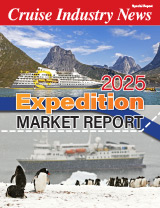With a growing fleet of larger cruise ships and an expanding pool of past passengers, cruise lines pursue different itinerary planning strategies, focusing on marquee ports that can accommodate the big ships to attract new passengers, while seeking new ports for experienced passengers, and meeting cost and revenue targets.
With average per diems below where they were before 2008, the pressure is on the planners to maximize the net contribution for each itinerary, that is, the revenues from shore excursions, and minimize costs, including fuel. Yet, they have to deliver a positive product experience and go to places that passengers want to visit.
For ports, location is increasingly important to minimize fuel burn, but ships will make exceptions and sail longer distances as long as passengers are willing to pay a premium or the ships can get there by sailing slower.
Overall, the pattern is predictable. Most ships go to the Caribbean during the winter and sail in the Mediterranean, Alaska or Northern Europe during the summer.
But more contemporary-market ships are exploring new sailing programs and calling at destinations and ports off the beaten path, such as in the Black Sea or in the North Atlantic going to Spitsbergen or the White Sea. Others explore Latin America or circumnavigate South America, even Africa. Some brands deploy seasonally in Asia.
Ships are also deployed and sourcing passengers from emerging markets, including Brazil, Australia, Japan and China. Some of the capacity is sourced from the traditional markets in North America in Europe.
For the planners, it means they have to develop itineraries for new markets that may prefer different cruise durations and destinations, while allocating some of the capacity to appeal to experienced cruisers from their main markets. Executives at Princess Cruises, for example, said that they believe the coastal sailings in Japan are very attractive to western markets, giving them an opportunity to experience Japan, without language or cultural barriers.
For the mass market, contemporary cruise ships, 4,000 passengers and more is common for the next generation of ships that ports must be prepared to accommodate.
In addition, ports may have to develop more extensive discharge services, and alternative shorepower in order to reduce emissions in ports is a hot topic for debate.
First and foremost, however, ports must offer shore excursions, contributing to the all important shipboard revenue stream. They are also expected to keep their costs in check. It is an evolving business model, where needs and demands reflect markets and their economic conditions.
Highlights:
“We will match the ships to the opportunities. Our strategy remains focused on North America,” said Terry Thornton, Carnival Cruise Lines, senior vice president of revenue management and deployment
“Itineraries tend to respond to economic trends, while seeking to maximize guest appeal and profitability. We have to balance all the external and operational aspects and trade off,” noted Chris Allen, Royal Caribbean and Celebrity, director of global deployment and itinerary planning
“As we get more ships, we are interested in expanding into more markets, and the proven ports that we are not presently sailing from are on our radar,” added Crane Gladding, Norwegian Cruise Line, senior vice president of revenue management and passenger services
“Not all the ports are at a level we would like to see. Nor are the costs where we would like them to be,” said Gianluca Suprani, MSC Cruises, corporate shore excursion manager
“The perfect port has low costs and generates high revenue,” said Crystal Morgan, Princess Cruises, director of market planning
“We have been able to really slow down the ships without sacrificing content,” said Simon Douwes, Holland America Line, director of deployment and itinerary planning
“To be profitable, a ship needs to homeport in a place with a sustainable source market,” advised William Ng, Star Cruises, chief operating officer
“We still have to offer strong itineraries to compete despite fuel cost rises,” explained Gerard Tempest, Carnival UK, commercial officer
“We are adding a lot more ports and fewer sea days and finding out that is what sells,” said Scott Kibota, Crystal Cruises, director of market planning
>> Also in this section: Over 40 cruise lines share their thoughts with Cruise Industry News behind the business decisions on ship deployment, where their ships are going and why.
Excerpt from Cruise Industry News Quarterly Magazine: Spring 2014



